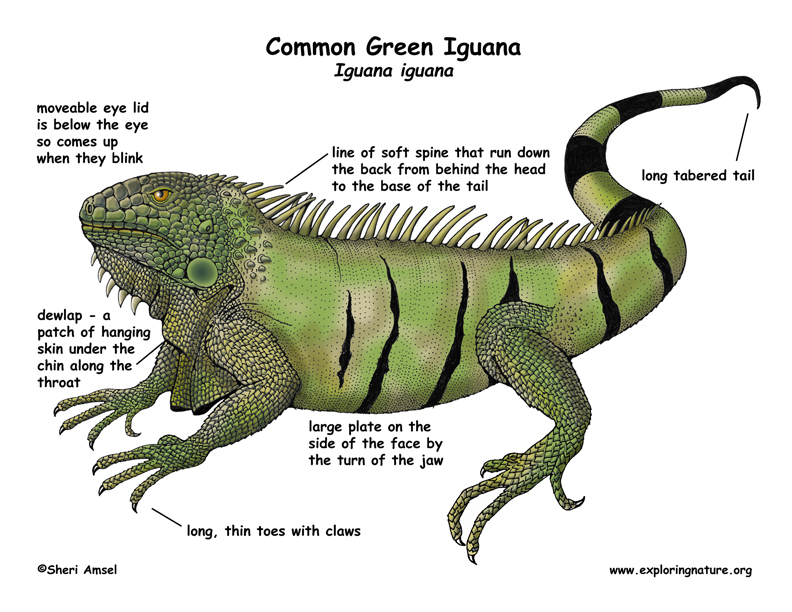

They are found in southern Florida (introduced), Hawaii (introduced), in the Caribbean, southern Mexico, throughout Central America and south through Brazil and Paraguay.
They live in the forest canopy (arboreal) and rarely go to the forest floor. They are often found in trees along rivers and will drop into the water to escape predators.
Adults can weigh up to 18 pounds (8 kg) and reach up to 6 feet (182 cm) long, including the long tail. They have a patch of hanging skin under the chin along the throat, called a dewlap. It is bigger in males. The dewlap spreads into an impressive fan when they are startled or display during a territorial confrontation or courtship. They also have a line of soft spines that run down the back from behind the head to the base of the tail. They have visible scales all over the body, though bigger and more distinctive on the head. There is one large plate on the side of the face by the turn of the jaw (subtympanic plate). Their moveable eyelids are below the eyes so come up when they blink. They vary in color from gray to bright green, with females being more consistently green. Young iguanas are patchy colored between green and brown and as they age settle into a more consistent color. They tend to be darker in the morning helping them absorb more sunlight and heat up their bodies. They fade in color as the day grows warmer. During mating season, a male can become bright orange. More dominant males are usually darker in color throughout the year.
They live in the trees (arboreal) and spend their days eating and sunning themselves. Being cold blooded, sunning is very important for maintaining their body temperature. As a result, they are territorial about their sunning perches and can be aggressive to protect them. When startled, they will stay perfectly still or if perched over water, drop into the water below. They are good swimmers. When attacked they will twist around or whip their tail. If a predator gets ahold of their tail, they can drop off some of it (and it will grow back later).
They mostly eat plants and fruits, but will take insects and spiders or feed on dead animals (carrion). Young iguanas eat more insects as they grow. They don't chew their food, but use their tongue position food so they can take small enough bites to swallow. After they eat, they need to sun. this helps them digest.
They are eaten by large birds of prey when young, but man is their biggest predator.
Male iguanas display in courtship by spreading their dewlap, bobbing their head and changing colors. Males can turn bright orange and will bite nip and nuzzle the females' neck. Female iguanas are pregnant for 2 to 2.5 months (gestation). They choose their nesting sites (dug into the ground) and may use the same site for several years. When ready to give birth, they lay 1-3 dozen cream-colored eggs over about three days. The eggs hatch in 3-4 months (incubation period). Hatchings can be up to 10 inches (25 cm) long and are fully independent. The parents do not care for the young.
Iguanas may live 8-10 years in the wild, but reach more than 20 in captivity. They are not considered at risk.
Kingdom: Animalia
Phylum: Chordata
Class: Reptillia
Order: Squamata
Family: Iguanidae
Genus: Iguana
Species: I. iguana
When you research information you must cite the reference. Citing for websites is different from citing from books, magazines and periodicals. The style of citing shown here is from the MLA Style Citations (Modern Language Association).
When citing a WEBSITE the general format is as follows.
Author Last Name, First Name(s). "Title: Subtitle of Part of Web Page, if appropriate." Title: Subtitle: Section of Page if appropriate. Sponsoring/Publishing Agency, If Given. Additional significant descriptive information. Date of Electronic Publication or other Date, such as Last Updated. Day Month Year of access < URL >.
Amsel, Sheri. "Iguana (Common Green)" Exploring Nature Educational Resource ©2005-2024. December 14, 2024
< http://www.exploringnature.org/db/view/537 >


